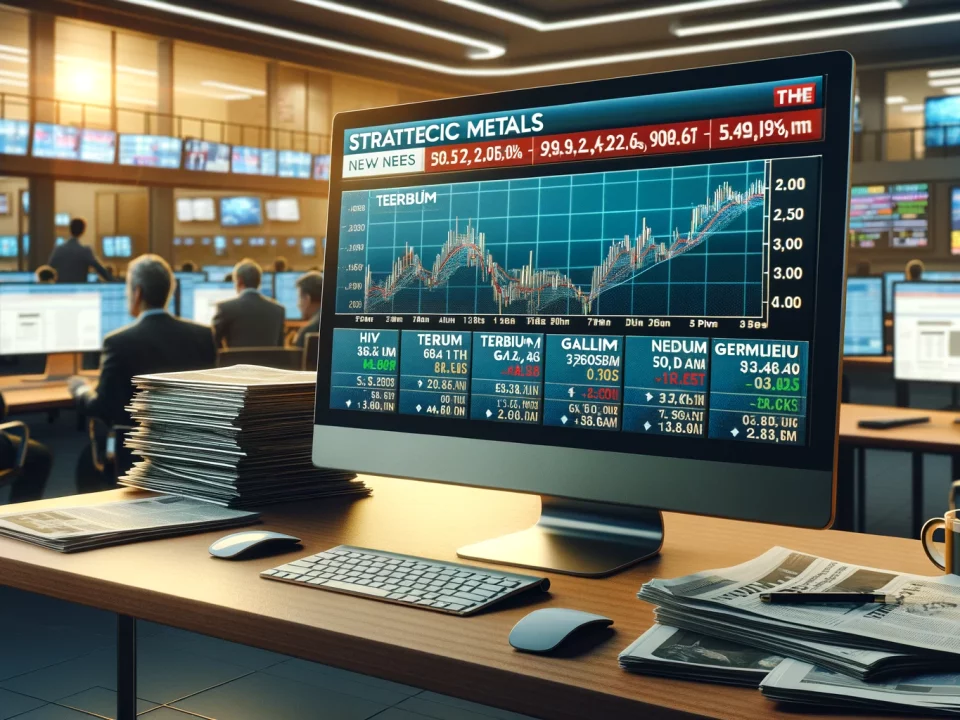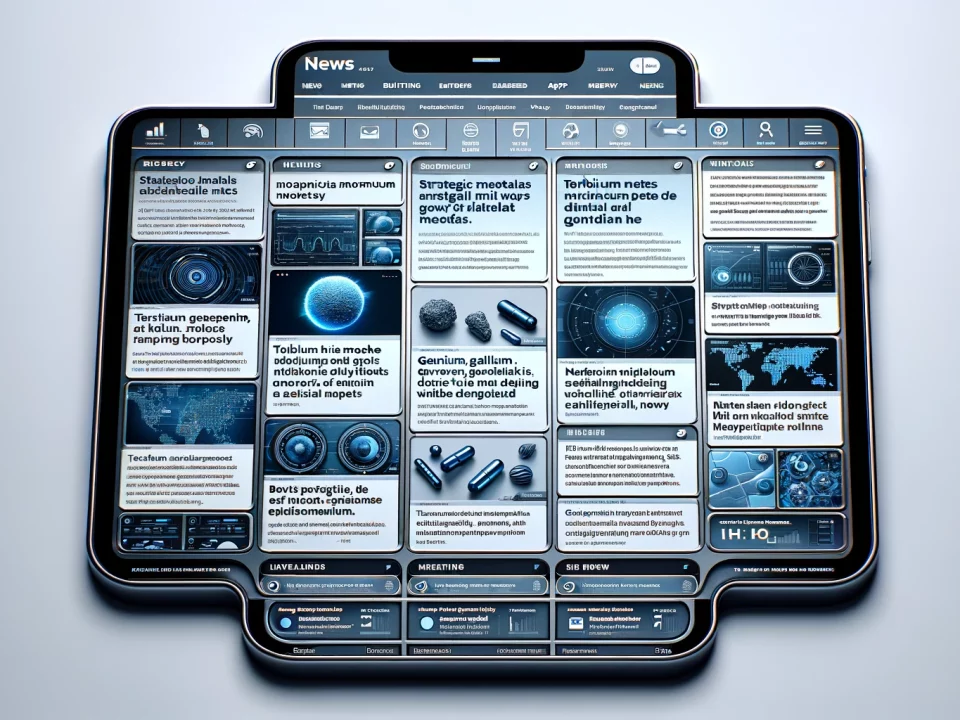
Weekly News Review Mar 25 – Mar 31 2024
March 31, 2024
Weekly News Review Apr 8 – Apr 14 2024
April 14, 2024STRATEGIC METALS: US GOVERNMENT FUNDS RESEARCH HUB –
The $75 million facility will support other ongoing projects to diversify and bolster supply chains.
The United States Department of Energy (DOE) will invest $75 million into a critical minerals supply chain research facility. According to a press release, the project funded by the Bipartisan Infrastructure Law will support existing government initiatives, such as the Critical Materials Innovation Hub, to diversify and strengthen supply chains of critical minerals needed for advanced technologies and renewable energies.
Challenges the facility is set to address include helping to meet the growing demand for critical minerals and raw materials and reducing dependence on foreign sources.
The production of many critical minerals, such as rare earths, is currently in Chinese hands. Efforts to shift this dynamic are underway in the U.S. and Europe, for example, through the Export-Import Bank of the United States, which recently offered millions to companies developing rare earth projects in Australia and Brazil.
WESTERN EFFORTS ARE NOT GOING UNNOTICED –
However, the industry leader, China, will not sit idly by. Beijing is continuously strengthening its expertise in the sector.
For example, through a recently unveiled rare earth innovation center located in Baotou in the Inner Mongolia Autonomous Region, home to the world’s largest rare earth reserves and already home to ten research platforms for rare earth technologies.
In addition, the People’s Republic is ramping up exploration efforts, announcing an eight percent higher budget for 2024 than last year.
NORTH AMERICA (USA): MP MATERIALS, MOUNTAIN PASS CALIFORNIA, AWARDED $58.5 MILLION TO ADVANCE RARE EARTH MAGNET FACILITY –
The project is the first fully integrated factory in the US. Production is set to start in 2025.
The domestic value chain of rare earth magnets in the United States continues to take shape. MP Materials, the operator of the only rare earth mine in the US, Mountain Pass, has been awarded $58.5 million by the IRS and the Treasury to advance the construction of its magnet factory in Fort Worth, Texas.
First announced in late 2021, the facility is planned to take feedstock from Mountain Pass and produce neodymium-iron-boron (NdFeB) magnets used in wind turbines and electric vehicle motors, for example. It is set to be the first fully integrated rare earth mine-to-magnet facility. MP expects production of precursor metals and alloys to begin this summer and final products in late 2025.
The first significant off-take agreement for the magnets produced in Fort Worth has been concluded with General Motors, which aims to bolster its North American electric vehicle supply chain.
In addition to MP, German magnet manufacturer Vacuumschmelze’s US subsidiary eVAC plans to finish constructing the second large-scale rare earth magnet facility in the US by 2025, located in Sumter County, South Carolina.
The grant is part of a $4 billion push by the Biden-Harris Administration to build clean energy supply chains, drive investments, and secure a steady supply of critical minerals. The move was announced last week.
AUSTRALIAN MINING COMPANY LINDIAN RESOURCES RECEIVES FINAL PERMISSION FOR MALAWI RARE EARTH PROJECT:
Kangankunde venture is now fully permitted for construction, mining, and processing.
Australian mining company Lindian Resources is now fully permitted to commence operation on its Kangankunde rare earth project in Malawi, a Southeastern African country. The company announced Tuesday that it received approval to extract groundwater at the operation in the country’s south, marking the final step in the permitting phase.
According to Lindian’s half-year report, Kangankunde is rich in neodymium and praseodymium. The two light rare earths are predominantly used to produce high-power permanent magnets for electric vehicle motors and wind turbines, for example. The report also disclosed the project’s currently estimated resources.
At 261 million tons of resource with an average of 2.19 percent total rare earth oxides, Lindian estimates Kangankunde to contain 5.72 million tons of rare earths, of which 20.2 percent are neodymium and praseodymium. This places the project among the world’s largest rare earth deposits. The company added that it will release its feasibility study for the first mining and processing stage later this quarter and publish updated resource updates and an ore reserve estimation ahead of the study.
Malawi: Kangankunde Not the Only Rare Earth Project:
Lindian’s Kangankunde project is one of many rare earth ventures in the small African country. At a third of the size of Germany, Malawi is one of Africa’s smallest nations. However, the country is gaining attention in the field of critical minerals. Besides Lindian, Canadian miner Mkango is also developing a rare earth project. The Songwe Hill project in the country’s southeast is the company’s furthest developed venture, but Mkango also holds multiple other exploration projects in Malawi.
In addition, a study by the US Geological Survey shows that the country is home to gold, titanium, graphite, and zirconium deposits.
ACLARA SEEKS TO PROCESS RARE EARTHS IN USA –
A new subsidiary is set to accelerate the development of processing capacities.
By establishing a subsidiary in the United States, mining group Aclara Resources (CHILE) wants to become the first vertically integrated company for heavy rare earths outside Asia.
The raw material is set to come from Chile and Brazil, where the Chile-based company, listed on the Toronto Stock Exchange, is developing raw material projects.
In both cases, the deposits are ion adsorption clays, from which only China and Myanmar extract rare earths. Around 16 percent of the world’s rare earth oxide production comes from this type of deposit.
The task of the newly founded Group subsidiary Aclara Technologies Inc. is to develop the capacity to process the material mined in South America into oxides. To this end, contracts have been concluded with the Saskatchewan Research Council for the technical process and Hatch Ltd. for economic feasibility studies. Whether and where the plant will be built depends on the results of the analyses. Technical research is expected to be completed by the end of the third quarter of 2024.
In March, Aclara Resources agreed on a joint venture with the Chilean CAP Group for further processing steps to produce metals and alloys from rare earths. The alloys can then be further processed by magnet manufacturers and used in electric cars or wind turbines.
To date, China has dominated the production of rare earths and the manufacture of permanent magnets from rare earths.
STRATEGIC METALS : TO STOCKPILE OR NOT?
Experts argue building up reserves is urgently needed.
Creating strategic reserves of critical raw materials could contribute much faster to securing supplies for the U.S. economy than new mining projects. At least that’s how industry insiders see it, according to Bloomberg. Instead of investing billions in projects that may not deliver results for many years, 600 million dollars could buy enough gallium, germanium, and cobalt for two years.
The current export restrictions and bans imposed by China are demonstrating the urgency of securing access to technology metals and rare earths.
At the same time, China’s strategy about resources could be a role model, Bloomberg quotes other voices from the industry. In China, the National Food and Strategic Reserves Administration manages stocks and stabilizes the market by buying or selling if necessary.
According to experts, the agency has good timing when intervening. According to estimates, it manages two million tons of copper, among other things, and makes decisions much faster than its US counterpart, the Department of Defense’s Defense Logistics Agency (DLA). The DLA must submit applications to Congress to purchase resources, which can take a whole year for approval.
The International Energy Agency (IEA) has also recently advocated building up reserves of raw materials. In this context, IEA Chairman Fatih Birol referred to the mechanism for maintaining the oil supply. The agency was founded in 1974 to avert shortages of fossil fuels. In contrast to crude oil, which the IEA members are obliged to hold in stock, the IEA advocates voluntariness for critical raw materials in a recent communiqué.
MINING: FROM DISCOVERY TO MARKET – IT TAKES DECADES –
Many years pass between the discovery of new mineral resources and their extraction.
The mining industry is facing a monumental task. It provides the raw materials required for the energy transition, from aluminum and copper to critical minerals like rare earths.
Western countries hope the construction of new mines will counteract their long-term dependence on China.
However, according to surveys, a lack of skilled workers and more difficult access to capital due to ESG guidelines for considering environmental, sustainability and social issues are causing headaches in the industry. Put simply, extracting natural resources is not only cost-intensive but also takes a lot of time.
Reports of new deposits being discovered are always exciting, but it can take decades before mines are fully operational and can contribute to supply.






